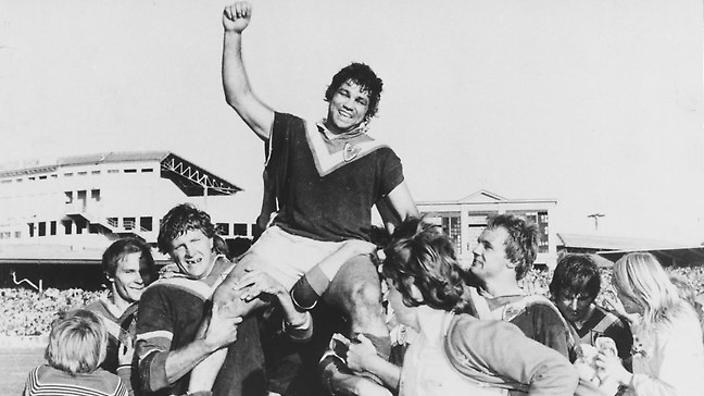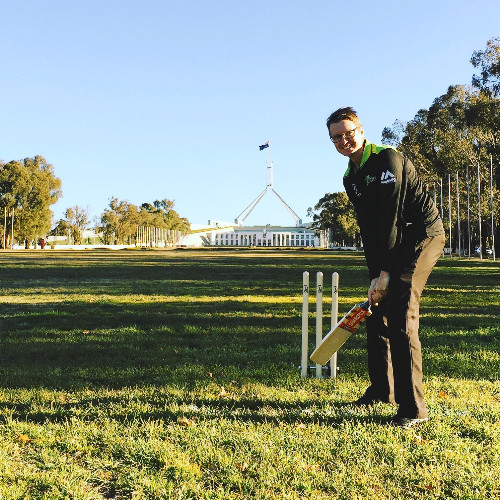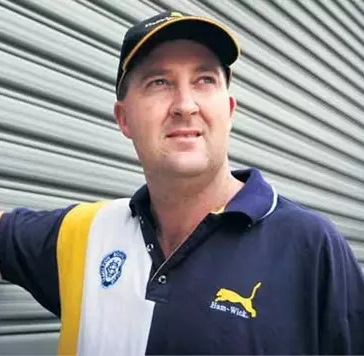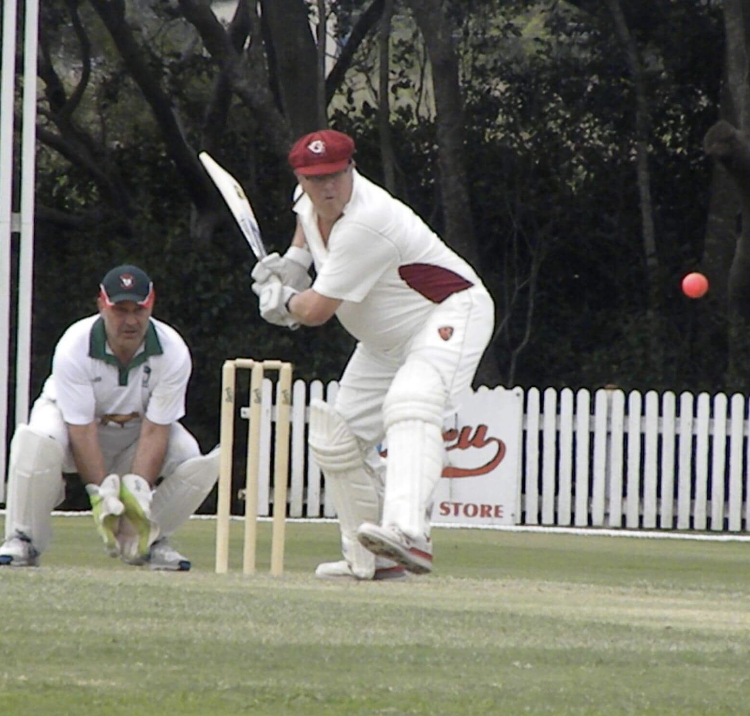About Me
Trent Ryan
Current Rating: 5 / 5
Real Estate Agent Image Property
https://imageproperty.com.au/
Brisbane, Australia
Played one day cricket for Queensland and Queensland Premier Cricket for Sandgate Redcliffe. Fully qualified cricket coach and played for the Australian Over 50s Cricket team
Partner Sponsors
My Activity
answered
Q: Select Your Best Test Cricket Team and Win $1,000 AUD!
Think you can create the ultimate Test cricket team? Here’s your chance to win $1,000 AUD by picking your best Test XI, following these simple rules:
1. Team Composition:
- Your team can only include a maximum of Two players from any one Test-playing nation.
- Select 11 players in batting order to form a balanced cricket team of batters, bowlers and a wicket keeper. Please nominate your wicket keeper.
2. Eligibility:
- You can only select players you’ve personally seen play a Test match live or on television.
- For instance, if you were born in 1970, players like Don Bradman are ineligible.
3. How to Submit Your Team:
- To participate, you must be a registered user on CricConnect.
- Register by providing your full name, email address, and password. Validate your email address, then publish your team in the answer section under this competition post.
- Teams published solely on CricConnect’s social media pages will not be considered.
4. Limitations:
- You can submit only one team.
5. Competition Period:
- Entries close at 12:00 pm AEST on 31st January 2025.
6. Winner Selection:
- All eligible entries will be entered into a random draw to win $1,000 AUD.
- The winner will be announced at 4:00 pm AEST on 31st January 2025.
7. Prize Details:
- There will be one winner only, receiving $1,000 AUD.
Start brainstorming your best Test team and submit your entry for a chance to win!
Have fun.
Think you can create the ultimate Test cricket team? Here’s your chance to win $1,000 AUD by picking your best Test XI, following these simple rules:
1. Team Composition:
- Your team can only include a maximum of Two players from any one Test-playing nation.
- Select 11 players in batting order to form a balanced cricket team of batters, bowlers and a wicket keeper. Please nominate your wicket keeper.
2. Eligibility:
- You can only select players you’ve personally seen play a Test match live or on television.
- For instance, if you were born in 1970, players like Don Bradman are ineligible.
3. How to Submit Your Team:
- To participate, you must be a registered user on CricConnect.
- Register by providing your full name, email address, and password. Validate your email address, then publish your team in the answer section under this competition post.
- Teams published solely on CricConnect’s social media pages will not be considered.
4. Limitations:
- You can submit only one team.
5. Competition Period:
- Entries close at 12:00 pm AEST on 31st January 2025.
6. Winner Selection:
- All eligible entries will be entered into a random draw to win $1,000 AUD.
- The winner will be announced at 4:00 pm AEST on 31st January 2025.
7. Prize Details:
- There will be one winner only, receiving $1,000 AUD.
Start brainstorming your best Test team and submit your entry for a chance to win!
Have fun.
A: 1. Virenda Sehwag
2. Barry Richards
3. Viv Richards
4. Sachin Tendulkar
5. Kumar Sangakkara
6. Imran Khan
7. Adam Gilchrist (wk)
8. Wasim Akram
9. Shane Warne
10. Dale Steyn
11. Curtley Ambrose
West Indies 2, Australia 2, Pakistan 2, India 2, South Africa 2, Sri Lanka 1.
2. Barry Richards
3. Viv Richards
4. Sachin Tendulkar
5. Kumar Sangakkara
6. Imran Khan
7. Adam Gilchrist (wk)
8. Wasim Akram
9. Shane Warne
10. Dale Steyn
11. Curtley Ambrose
West Indies 2, Australia 2, Pakistan 2, India 2, South Africa 2, Sri Lanka 1.
answered
Q: Who is the fastest bowler you’ve ever faced in a game of cricket?
A: The "fastest" can be a little bit subjective and depends on a few factors; but I will give it a shot.
I was lucky enough, I guess you could say, to play a couple of games against the West Indies when they had some good quicks. This is where the subjective part comes in:
Malcolm Marshall - only faced 2 balls and hard to say how quick he bowled them as I did not see either of them due to the speed of his bowling arm through the gather and release. That was pretty scary considering I wasn't wearing a helmet.
Patrick Paterson - consistently fast through an entire spell, but I found ball tracking out of his hand easier to focus on. I have photos from side on from this game and David Williams (keeper) was outside the 30 yard circle. So, I think he was bowling pretty sharp that day.
Anderson Cummins - fastest single delivery, I hit him for a couple of 4's back down the ground and the follow up bouncer was as sharp as anything I ever faced.
In Brisbane Grade cricket I faced quite a few quality quicks, and I think Greg Rowell would be top of the list. Especially for consistent pace, every match (every ball come to think about it) mattered to him.
As a child my older brother in the backyard with a shaved tennis ball on a wet plastic slip and slide, pitch length of around 7-8 meters was pretty sharp too, and nearly as scary.
I was lucky enough, I guess you could say, to play a couple of games against the West Indies when they had some good quicks. This is where the subjective part comes in:
Malcolm Marshall - only faced 2 balls and hard to say how quick he bowled them as I did not see either of them due to the speed of his bowling arm through the gather and release. That was pretty scary considering I wasn't wearing a helmet.
Patrick Paterson - consistently fast through an entire spell, but I found ball tracking out of his hand easier to focus on. I have photos from side on from this game and David Williams (keeper) was outside the 30 yard circle. So, I think he was bowling pretty sharp that day.
Anderson Cummins - fastest single delivery, I hit him for a couple of 4's back down the ground and the follow up bouncer was as sharp as anything I ever faced.
In Brisbane Grade cricket I faced quite a few quality quicks, and I think Greg Rowell would be top of the list. Especially for consistent pace, every match (every ball come to think about it) mattered to him.
As a child my older brother in the backyard with a shaved tennis ball on a wet plastic slip and slide, pitch length of around 7-8 meters was pretty sharp too, and nearly as scary.
answered
Q: Who is the one player from Brisbane Grade Cricket who played between 1980 and 2000 you’d want as the first player selected if you had the opportunity to start your own Queensland Premier first grade cricket team?
A: Gavin Fitness
question
Q: Peter Charles affectionately known as "Sting" was the best Captain I played under, or more correctly with. Sting never set himself as being above any team member in ability or importance. In the Queensland Cricket Premier Competition, back in the day, there were 9 District Clubs and to avoid a Bye in First Grade Qld Cricket would field a "Colts XI". QC would appointment a Captain/Coach and the 9 clubs would each nominate 2 players under the age of 21 as the squad for selection. The side would train together, and our home ground was The Gabba.
You could not play for more than 2 seasons for Colts, and it was originally used to give exposure to fringe first grade players that may not play at the home club
You could not play for more than 2 seasons for Colts, and it was originally used to give exposure to fringe first grade players that may not play at the home club
https://www.cricconnect.com/profile/64/trent-ryan/blog/1829/trent-ryan-my-best-captain
blog post
Peter Charles affectionately known as "Sting" was the best Captain I played under, or more correctly with. Sting never set himself as being above any team member in ability or importance. In the Qu ...
answered
Q: I’m a young offspinner playing grade cricket in Melbourne and have a question about bowling in one day games.
Our captain wants me to bowl flat and full-to middle stump so we can have 3 players on the boundary to keep the runs down and look to get the batter out bowled or LBW.
My preference is to bowl with more loop just outside off stump and spin the ball back towards the stumps. I feel more comfortable as some balls will turn more than others and I’m hoping to beat the outside and inside edge of the bat.
I’d like to get some advice on which is the better way. He is the captain, so I do as I’m ask but I find it difficult.
Thanks
Our captain wants me to bowl flat and full-to middle stump so we can have 3 players on the boundary to keep the runs down and look to get the batter out bowled or LBW.
My preference is to bowl with more loop just outside off stump and spin the ball back towards the stumps. I feel more comfortable as some balls will turn more than others and I’m hoping to beat the outside and inside edge of the bat.
I’d like to get some advice on which is the better way. He is the captain, so I do as I’m ask but I find it difficult.
Thanks
A: I suggest have an in depth chat with him about your own bowling philosophy and how you will take wickets, not stop runs. Talk about subtle bowling variation changes, field placements required, bowling at different times in the innings etc.
The best scenario is your white bowl bowling will have an underlying method, with a range of variations of your stock
ball as the most important factor. Bowling the same thing to every batter soon becomes an easy tasks for them to make decisions on what shot to play. Having the confidence in your bowling, and the freedom to change the field as you see fit, is the ultimate outcome. More often than not this is main obstacle in ensuring the Captain trusts your bowling and what you want to do, they cannot hand over the freedom.
The more you talk to the Captain about letting you be the Captain of your bowling the more likely that is to occur.
The best scenario is your white bowl bowling will have an underlying method, with a range of variations of your stock
ball as the most important factor. Bowling the same thing to every batter soon becomes an easy tasks for them to make decisions on what shot to play. Having the confidence in your bowling, and the freedom to change the field as you see fit, is the ultimate outcome. More often than not this is main obstacle in ensuring the Captain trusts your bowling and what you want to do, they cannot hand over the freedom.
The more you talk to the Captain about letting you be the Captain of your bowling the more likely that is to occur.
answered
Q: If there was one rule you could change in cricket what would it be?
A: I have 2 rules for change:
1. The overthrow that hits the batter, the ball is deemed dead so batters cannot run extra runs, but if the ball makes the boundary its 4. Contradictory!
2. We need a 5 run option, without overthrows. So, if the ball goes over the boundary on the full but is touched inside the field of play by a fielder and a catch is not completed for a dismissal of the batter, then it is only 5 runs scored. If you want 6 runs hit it over the boundary untouched.
1. The overthrow that hits the batter, the ball is deemed dead so batters cannot run extra runs, but if the ball makes the boundary its 4. Contradictory!
2. We need a 5 run option, without overthrows. So, if the ball goes over the boundary on the full but is touched inside the field of play by a fielder and a catch is not completed for a dismissal of the batter, then it is only 5 runs scored. If you want 6 runs hit it over the boundary untouched.
answered
Q: I’m the coach of an under 16 school team and would like to get some advice about the best way to break down the team chasing say 100 runs to win a one-day game with 15 overs to go in the innings. The players seem to get caught wanting to play big shots and we often fall 30 or 40 runs short. Any help would be great
A: Always a tough task in teenage cricket, chasing a total, sometimes 50 in 100 balls is diifficult.
I coached a year 10 school side, (15 and 16 year olds) side this season and we won 6 games batting second, with the best chase 228 off 40 overs, we had 2 overs spare in that win.
A few things that we emphasised in training that I found effective were:
Set your target to win with an over to spare, so your 100 in 15 is really a 100 off 14. Somewhere in the chase you will have at least one over of low scoring so stay in front of your target score. Try not to get to the last over if possible, then if the game does come to the last over you only be needing 1 to 3 runs instead of 8-10.
Running between wickets is the king, must be aggressive with their backing up and there is a 1 from most throws from the boundary (depending on field size).Singles within the 30 meter circle are best achieved with soft hitting, get the dominant hitter on strike as much as possible.
Train hitting the ball over the head of the fielders in the circle, this gets 2 or a 4 runs, risks are a necessity so hitting it continually straight to the fielder in the deep for 1 is not productive enough because there will be dot balls.
Practice hitting bombs, the kids love it! We often had long hitting contest, but use a variety of shots so they hitting to all parts of the ground. Bad balls should be hit for 4 or 6. If it is fun at training and a challenge the players really take it to task and it builds a positive mind set.
Develop a full array of shots for the players, reverse sweeps, ramps etc again I find they like the challenge also they are standard shots now, so they should learn the skills. Scoring boundaries between mid-off and point is a great skill to have and it makes the opposition field placement much more difficult, practice hitting it hard in that area.
Each player must know what their strengths are in a run chase, (teenage boys need constant reminders of this), it makes their task simpler when they get to the crease. Keep re-enforcing where their 1 zone, 2 zone and boundary zones are on the field. Play to those limits.
The scoreboard needs updating every over, not sure why but they are not great at this. In coming batsman must know the rate needed when they arrive at the crease.
Finally it really helps if you have a good player with a level head that control things, they aren't in every side though.
Hope this helps in some way for you.
I coached a year 10 school side, (15 and 16 year olds) side this season and we won 6 games batting second, with the best chase 228 off 40 overs, we had 2 overs spare in that win.
A few things that we emphasised in training that I found effective were:
Set your target to win with an over to spare, so your 100 in 15 is really a 100 off 14. Somewhere in the chase you will have at least one over of low scoring so stay in front of your target score. Try not to get to the last over if possible, then if the game does come to the last over you only be needing 1 to 3 runs instead of 8-10.
Running between wickets is the king, must be aggressive with their backing up and there is a 1 from most throws from the boundary (depending on field size).Singles within the 30 meter circle are best achieved with soft hitting, get the dominant hitter on strike as much as possible.
Train hitting the ball over the head of the fielders in the circle, this gets 2 or a 4 runs, risks are a necessity so hitting it continually straight to the fielder in the deep for 1 is not productive enough because there will be dot balls.
Practice hitting bombs, the kids love it! We often had long hitting contest, but use a variety of shots so they hitting to all parts of the ground. Bad balls should be hit for 4 or 6. If it is fun at training and a challenge the players really take it to task and it builds a positive mind set.
Develop a full array of shots for the players, reverse sweeps, ramps etc again I find they like the challenge also they are standard shots now, so they should learn the skills. Scoring boundaries between mid-off and point is a great skill to have and it makes the opposition field placement much more difficult, practice hitting it hard in that area.
Each player must know what their strengths are in a run chase, (teenage boys need constant reminders of this), it makes their task simpler when they get to the crease. Keep re-enforcing where their 1 zone, 2 zone and boundary zones are on the field. Play to those limits.
The scoreboard needs updating every over, not sure why but they are not great at this. In coming batsman must know the rate needed when they arrive at the crease.
Finally it really helps if you have a good player with a level head that control things, they aren't in every side though.
Hope this helps in some way for you.
answered
Q: In relation to the Mankad issue and its increased regularity especially in T20 cricket.
Bowlers are penalised for going 1mm over the crease for a no ball and it cost the team one run plus a free hit which could mean the penalty is 7 runs if the free hit is hit for 6. Bowlers are also penalised if they’re stray outside the markers and the ball is called a wide and it could also cost their team 7 runs if the additional bowl is hit for 6. That’s all fine because it’s in the rules.
The Mankad is in the rules but it’s not a good look and creates tension amongst the players so with all the technology involved in the game what if a penalty is introduced to the batting team if the batter leaves the crease before the ball is bowled.
The technology and penalty take the pressure off the bowlers and the umpires and like the bowler’s penalties means the batters have to stick to the rules of the game.
Is 2 or 3 runs too much of a penalty, keen to get your thoughts.
Bowlers are penalised for going 1mm over the crease for a no ball and it cost the team one run plus a free hit which could mean the penalty is 7 runs if the free hit is hit for 6. Bowlers are also penalised if they’re stray outside the markers and the ball is called a wide and it could also cost their team 7 runs if the additional bowl is hit for 6. That’s all fine because it’s in the rules.
The Mankad is in the rules but it’s not a good look and creates tension amongst the players so with all the technology involved in the game what if a penalty is introduced to the batting team if the batter leaves the crease before the ball is bowled.
The technology and penalty take the pressure off the bowlers and the umpires and like the bowler’s penalties means the batters have to stick to the rules of the game.
Is 2 or 3 runs too much of a penalty, keen to get your thoughts.
A: How about something completely left field, if you get caught leaving early, for the remainder of your innings your feet must make the ground past the crease when running between wickets, not just your bat. This could cost countless runs during an innings.
answered
Q: I’m new to umpiring and have become quite fascinated about the psychology of the different guards’ batters choose when they come out to bat.
Batters ask for middle stump, leg stump, middle to leg, one leg, leg stump to off stump and other variations. Can I ask what you choose and the reason why?
Batters ask for middle stump, leg stump, middle to leg, one leg, leg stump to off stump and other variations. Can I ask what you choose and the reason why?
A: As mentioned by others, it is to enable the batter to be aware of where his stumps are, and being able to cover them with their footwork. I played through junior cricket on centre, and then continued using centre as my reference point through my grade cricket career and still do now, playing Veterans cricket.
What I do now is vary where I stand in relation to centre, based on the wicket conditions and bowling. I move deeper in the crease, out of the crease, leg stump, off stump, sometimes multiple times per over in an attempt put pressure on the bowler. It helps when considering their field placements and my intent to increase the chance of scoring runs.
What I do now is vary where I stand in relation to centre, based on the wicket conditions and bowling. I move deeper in the crease, out of the crease, leg stump, off stump, sometimes multiple times per over in an attempt put pressure on the bowler. It helps when considering their field placements and my intent to increase the chance of scoring runs.
blog post
My cricket cap collection. From left to right with the fifth row being the back rowFifth Row CCC Tour of Australia 1988 - regional Indian T ...
answered
Q: What advice or drills would people offer to a young batter who drops their back hip when playing forward in defence or attack?
A: Such a common problem with a few different issues normally associated, let's try and cover a couple of them. First thing I normally check is for an even distribution of weight through each foot in their stance and their head centered. May as well start in a balance position. I also find that batters that have this concern have a bottom hand dominant grip, its low on the handle and holds the bat tightly. So I encourage them to loosen this off (squash ball as per Gilchrist in 2007 World Cup works a treat) as well as keeping hands together and more to the top of the handle rather than the bottom, helps to achieve a full swing of the bat.
To me one the keys of transferring weight forward when playing front foot shots is place an emphasis on the lead shoulder and use it as the key body part for the batter to be aware of. Point that shoulder in the direction they want to hit the ball, the head follows automatically and their weight transference is then in the direction of the shot. Its hard to achieve that if the weight is dropping into the back hip. If they get that right you are well on your way to solving the issue.
What can also be useful is to "back-chain" the skill. Place the batter in the end position of the shot, i.e. full follow through with hands up and over the front shoulder. Drop balls from in front and to the side of the batter and ask them to step forward and finish their shot in that position. You can vary their hitting direction from midoff to mid on direction with the emphasis on the front should alignment position.
Then its a matter of repetition, patience and appropriate positive re-enforcement in the coach's verbal communication. The more balls they have hit with their old method the more they need to hit to embed the change.
To me one the keys of transferring weight forward when playing front foot shots is place an emphasis on the lead shoulder and use it as the key body part for the batter to be aware of. Point that shoulder in the direction they want to hit the ball, the head follows automatically and their weight transference is then in the direction of the shot. Its hard to achieve that if the weight is dropping into the back hip. If they get that right you are well on your way to solving the issue.
What can also be useful is to "back-chain" the skill. Place the batter in the end position of the shot, i.e. full follow through with hands up and over the front shoulder. Drop balls from in front and to the side of the batter and ask them to step forward and finish their shot in that position. You can vary their hitting direction from midoff to mid on direction with the emphasis on the front should alignment position.
Then its a matter of repetition, patience and appropriate positive re-enforcement in the coach's verbal communication. The more balls they have hit with their old method the more they need to hit to embed the change.
answered
Q: I'm 18 and bowl left arm orthodox. I'd like to ask where the teams best fielders should be fielding when the spinners are bowling?
A: The best fielders should be where you expect most balls to be hit. If the wicket is not turning a lot then they will occupy straighter fielding positions, e.g. mid off, cover, mid on. If the wicket is turning then squarer positions on the offside for right handers, squarer leg side positions for left handers.
answered
Q: As Aaron Finch calls stumps on his outstanding international career who do cricket fans believe should be the next Australian T20 Cricket Captain?
A: I think we probably need someone who will nearly always be in the side so going for Glenn Maxwell. Great T20 player and has had more experience than anyone in the possible line up and has been a pretty good Captain for his franchises.
answered
Q: What's the best cricket shot to learn to play well?
A: Back foot vertical bat attacking shot. If you can play this one well then front foot vertical bat shots are easy as well. Best to learn a full swing of the bat first as it will highlight and balance and grip issues a player may have. Defensive shots are then just attacking shots without a follow through. Horizontal bat shots to the leg side are a pretty natural swing pattern for most people so they don't need anywhere as much attention to develop.
Master the vertical bat first then develop the rest of the game.
Master the vertical bat first then develop the rest of the game.
blog post
I have always loved playing the game and still do. Cricket really is a sport for life, and I love the fact it has led to many friendships with past and current team mates, opponents (some of ...
answered
Q: I was just wondering if you have any tips on how to bat when you’re coming of a few low scores and a bit low on confidence. How you should just go about it?
A: Hi James, if this could be overcome without too many issues everyone would be a coach, or we wouldn't need them at all.. As a top order batter with nearly 50 years of playing experience in the bank I have been in this position a number of times. The best advice I have received, or heard, was by Dr Phil Jauncey, he is a well known sports psychologist and has worked with the Aussie Test side and many other professional sports organisations, Olympic teams etc.
Phil is a none-believer in "form", players have ability and no-one takes away your ability when you have a run of low scores, technical ability that is. The lack of confidence is a mental state, so you need to assess your thought process in your approach to your batting during a run of low scores. A clear mind is essential for success as a batter. The batting skill has 3 components, perception (determine what the ball is doing), decision (what shot is to be played) and technical application of the shot. The quicker the first 2 are done then leaves more time for the shot execution. Therefore a clear mind so that a quick, concise and correct decision is made is vital. Self doubt and second guessing slow down your decision making and therefore lessen the chance of executing your shot.
The common phrase when top test batters are going well is how much time they have to play their shots. Its not that the bowler slows down for them, they just perform the first 2 components quicker than other batters. A clear mind for decision making is a key component. Have faith in your ability, know your strengths as a player and play within them when batting in a match. The only ball that matters is the next one.
We could be here all day on this subject, hope these little bits can help you back into the runs.
Phil is a none-believer in "form", players have ability and no-one takes away your ability when you have a run of low scores, technical ability that is. The lack of confidence is a mental state, so you need to assess your thought process in your approach to your batting during a run of low scores. A clear mind is essential for success as a batter. The batting skill has 3 components, perception (determine what the ball is doing), decision (what shot is to be played) and technical application of the shot. The quicker the first 2 are done then leaves more time for the shot execution. Therefore a clear mind so that a quick, concise and correct decision is made is vital. Self doubt and second guessing slow down your decision making and therefore lessen the chance of executing your shot.
The common phrase when top test batters are going well is how much time they have to play their shots. Its not that the bowler slows down for them, they just perform the first 2 components quicker than other batters. A clear mind for decision making is a key component. Have faith in your ability, know your strengths as a player and play within them when batting in a match. The only ball that matters is the next one.
We could be here all day on this subject, hope these little bits can help you back into the runs.
answered
Q: My son is 14 and I want to help him play the pull and hook shots the right way. Is it better to teach him to play the shots with his hands coming up under the ball or try and get his hands up higher and over the ball so he has a better chance to hit the ball along the ground?
A: Develop both skills as they both play a part in maximising your run scoring opportunity, especially in the white ball format of the game. In white ball cricket it is important to hit the ball in the air over the fielders that are within the 30 meter circle, as there is in all probability no fielder behind them on the boundary. Your strike rate can be greatly improved by hitting in the air to these spaces as it most often returns 2 or 4 runs, if powerful enough then 6 runs. A shot along the ground to the deep fielders is nearly always just a single. Plus the more skills you have as a batter the better and it will keep your son's training more enjoyable to do both.
answered
Q: Where should your head be towards during your stance while the bowler is releasing the ball. I am keen to know your opinion!
A: In a eyes level position directly above your base of support and centre of gravity.
answered
Q: What is the most surreal moment you've experienced in cricket?
A: Facing Anderson Cummins when playing against the West Indies, turning around after watching a bouncer go past my nose and David Williams, their keeper, is taking it one handed, high above his head. and he is outside the 30 meters circle.
answered
Q: I’m 23 and a captain in my first season. I want to ask why spinners are so quick to want a fielder at deep point. In my opinion it’s just an easy single for the batter?
A: I guess it depends on what type of spin they bowl, is it to just right hand or left hand batters, pitch conditions, state of the game etc. Most spinners will start with and keep a deep square leg to prevent boundaries, a deep fielder on the off can provide similar cover. What I would consider more important is their plan to take wickets. If it fits into that concept then all well and good. If it does not match their plan then it will need adjusting. A good discussion point for you, the skipper, and the bowler to undertake next training session.
answered
Q: My son is a 15 year old wicket keeper and when he has questions we jump on youtube and look at wicket keeping videos. One thing we noticed is Australian wicket keepers like Gilchrist and Haddin keep the feet close together in their stance but English wicket keepers have a really wide stances. Why is that and which is the better stance for keepers?
A: There is no better way in my opinion, each player is different in their preference. What the stance needs to allow the keeper to do is; move easily in each direction, allow for the hands and eyes to remain close to the same level and have the hands travel up with the ball as it rises off the pitch.
answered
Q: What are the key factors in winning a competition? Anything from developing a side that can do it; off field culture; team expectations; etc.
A: While this should not be the main focus of your season/tournament in terms of verbal re-enforcement to the players, in my opinion you cannot achieve something unless you have it as your goal - WIN! Win whatever competition you are playing in and base your preparation around how that is best achieved with the players you have at your disposal. Plan for success!
Recognise and adapt your coaching/captaincy to the different personality traits of all players within the squad. You can't treat everyone the same and the players need to understand and recognise these differences as well.
Have clearly defined squad expectations that are non-negotiable (playing and training based), best scenario is the players identify, implement and monitor these themselves.
The "senior or most admired" players in the group all need to be on-board with what the coach/captain wants to achieve and how it will be achieved. Their efforts and attitude need to reflect this at all times. Constant reassessment of the tournament or season can see changes implemented where and when required.
Practice and training are 2 completely different things and both need to be included in the preparation of the players. Practice current skills under as much pressure as possible. Train and implement new skills constantly.
All players should improve through the course of the team's preparation/season in all 5 key areas -technical, tactical, psychological, physiological and socially.
You can either practice hard or long, never schedule a session/week that is a combination of the 2. Players hate it and burn out is not great preparation for anyone. Recovery days/weeks are vital for prime performances over a tournament or a season.
Individual and team successes,( sometimes this is just improvement), need to be publicly acknowledged, rewarded and celebrated by the entire playing group. Especially celebrate winning! Recognition of your success as a team is your opponents will hate you, and hate playing against you. Be the feared team of the competition!
As a coach/captain/leader constantly perform a self assessment and ask for feedback from all players in the team/squad. Willingness to improve and listen go a long way to a happy playing group.
I always like a good quote as well so here are a couple:
IF IT'S MEANT TO BE THEN IT'S UP TO ME! Take responsibility for everything that happens.
THERE IS NO TRAFFIC JAM ON THE EXTRA MILE! Leave no stone unturned in your pursuit of victory.
Recognise and adapt your coaching/captaincy to the different personality traits of all players within the squad. You can't treat everyone the same and the players need to understand and recognise these differences as well.
Have clearly defined squad expectations that are non-negotiable (playing and training based), best scenario is the players identify, implement and monitor these themselves.
The "senior or most admired" players in the group all need to be on-board with what the coach/captain wants to achieve and how it will be achieved. Their efforts and attitude need to reflect this at all times. Constant reassessment of the tournament or season can see changes implemented where and when required.
Practice and training are 2 completely different things and both need to be included in the preparation of the players. Practice current skills under as much pressure as possible. Train and implement new skills constantly.
All players should improve through the course of the team's preparation/season in all 5 key areas -technical, tactical, psychological, physiological and socially.
You can either practice hard or long, never schedule a session/week that is a combination of the 2. Players hate it and burn out is not great preparation for anyone. Recovery days/weeks are vital for prime performances over a tournament or a season.
Individual and team successes,( sometimes this is just improvement), need to be publicly acknowledged, rewarded and celebrated by the entire playing group. Especially celebrate winning! Recognition of your success as a team is your opponents will hate you, and hate playing against you. Be the feared team of the competition!
As a coach/captain/leader constantly perform a self assessment and ask for feedback from all players in the team/squad. Willingness to improve and listen go a long way to a happy playing group.
I always like a good quote as well so here are a couple:
IF IT'S MEANT TO BE THEN IT'S UP TO ME! Take responsibility for everything that happens.
THERE IS NO TRAFFIC JAM ON THE EXTRA MILE! Leave no stone unturned in your pursuit of victory.
answered
Q: A scenario – the first over of an innings and the captain has set two slips, a gully, point, cover, mid off, mid on, mid wicket and a fine leg.
The bowlers first two balls are outswingers and the batter plays and misses both. Should the captain contemplate a field change and what would you suggest?
The bowlers first two balls are outswingers and the batter plays and misses both. Should the captain contemplate a field change and what would you suggest?
A: It would seem the perfect time to have a third slip put in. I would leave the mid-off area open, maybe have cover come a bit straighter. Given the ball is swinging it is harder for the batter to hit it straighter, squarer with the swing being more likely. Basing this answer on a right hand batter and the play and misses are on the outside edge of the bat.







































